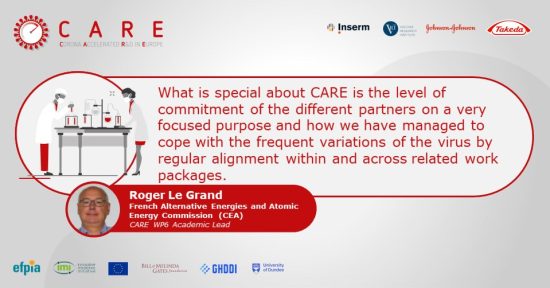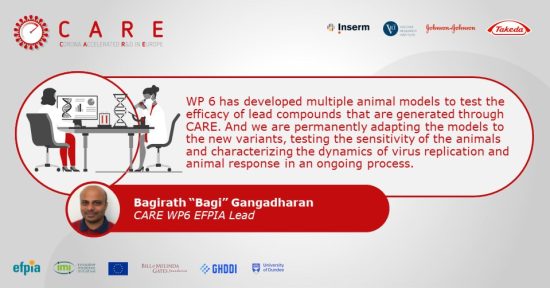September 22nd 2022
The faces behind the CARE work-packages – WP6
The faces behind the CARE work-packages – WP6
CARE (Corona Accelerated R&D in Europe) is the largest European research initiative addressing the challenges of COVID-19. It is no surprise that it is designed in a comprehensive, yet agile, structure to fulfill the 37 partners’ shared key goals: (1) to identify therapeutics for the current pandemic, (2) to identify antiviral therapies for future outbreaks and (3) to increase the understanding of the pathophysiology of COVID-19. In a set-up of eight work-packages (WPs), the scientists and management at CARE carry out the project activities that have so far resulted in valuable learnings about COVID-19 and how it might be defeated.
In this monthly series, we go behind the scenes through brief interviews with the leadership of each of the eight CARE work-packages to hear insights on what makes their work so special, as well as their challenges and hopes.


WP6 – From lead to pre-clinical candidate and proof-of-concept in in vivo models
The CARE work-package 6 (WP6) aims to to pre-clinically assess ADME, PK:PD, potency and safety of therapeutic candidates in vitro and in vivo models. Roger Le Grand (CEA) and Bagirath Gangadharan (Takeda) provided us in a short interview with insights into the activities of this work package, its highlights and the challenges that they had to overcome.
How has the collaboration within your WP team developed over the past two years?
Roger: The virus has challenged us with its frequent variations. To cope with this, we have expanded an already strong collaboration model with regular WP 6 meetings and dedicated project managers by adding trans-work package meetings, for instance with WP 4/7 for the antibody development, and with WP 3/7 for the small molecule development. And once we started testing a specific drug, we moved from more general data sharing to more specific interactions with one or two partners that are fully involved in this drug. An example is the work we did with the Lausanne group (CHUV) – because they brought an antibody into the pipeline to be tested in the non-human primate model. Another example is the early work with Dundee on the NSP14 series.
What has surprised you about working on the CARE project?
Roger: I think what we can consider unique in this consortium is the level of the contribution of the European Union to the large taskforce to find therapeutics for COVID-19 – this was put in place very quickly following the beginning of the pandemic. It is also amazing to see how quickly the diverse groups across academic and industry partners are managing to adapt processes and the amount of learnings is just enormous.
What makes the work for CARE special for you and your WP team?
Roger: I think what is different is the level of commitment of the different partners on a very focused purpose – taking into consideration that we have a large number of partners. In other collaborations very often people start focusing their efforts on their own interests very quickly and I think that CARE does a great job in keeping this focus on common interests. We have built a legacy with all the tools, the screening processes, the animal models, the methodology for the clinical trials being in place – in the future this will be very useful for other types of infections.
What highlights can you share from two years with your WP team so far?
Bagi: WP6 has developed multiple animal models to test the efficacy of lead compounds that are generated through CARE. This includes transgenic and humanized mouse models and a Syrian gold hamster model – these will be used for efficacy studies of our leading antiviral hit compounds, as derived from WP1-4. Additionally, also mouse-adapted SARS-CoV-2 strains will be used in the mouse model. A non-human primate model was developed for testing late-stage stage compounds, to look at both efficacy and pharmacokinetics. This is a big achievement, if you consider that we started from scratch with a new virus. There are several small molecules and mAbs that have been tested in the hamster model and we have tested mAbs in the non-human primate model, which contributed to the progression of the CHUV Ab to clinical trials (outside of CARE). This will all help to test other lead compounds to bring to clinical trials.
What are or were the biggest challenges within WP6? (and how did you overcome them?)
Bagi: What is difficult for us and WP6 is to permanently adapt the models to the new variants. You need to test the sensitivity of the animals to these new variants, to characterize the dynamics of its replication and the animal response – this is an ongoing process. Working in a consortium with great academic research partners working closely together as a team, we can share resources very fast between us and adapt our processes for drug testing by internal discussion very quickly.
